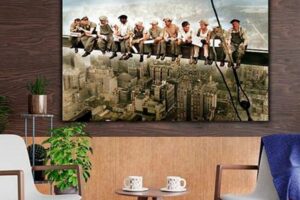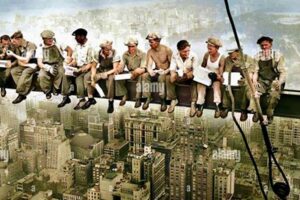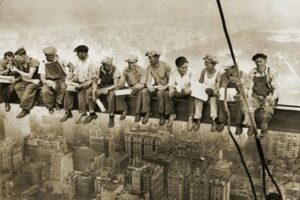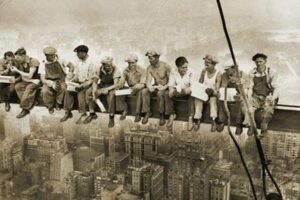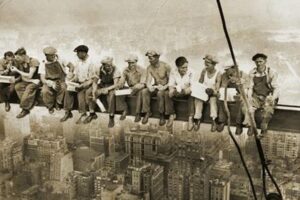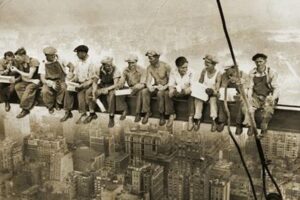The iconic “Lunch atop a Skyscraper” photo, taken in 1932, depicts eleven construction workers casually eating lunch while perched precariously on a steel beam, high above the streets of Manhattan. The image has become a symbol of both the bravado and the risks inherent in the construction of New York City’s skyscrapers during the early 20th century.
The photo was taken by Charles C. Ebbets, a photographer for the Bethlehem Steel Corporation, during the construction of the RCA Building at 30 Rockefeller Plaza. Ebbets was tasked with documenting the progress of the construction project, and he often took photos of the workers as they went about their dangerous work. The “Lunch atop a Skyscraper” photo was taken during one of these routine photo sessions.
The photo quickly became one of the most iconic images of the 20th century. It has been reproduced countless times in books, magazines, and newspapers, and it has been used in advertising campaigns and even in works of art. The photo has also been the subject of much debate and speculation, with some people questioning whether it was staged or if the workers were actually eating lunch at the time the photo was taken. Regardless of the circumstances surrounding its creation, the “Lunch atop a Skyscraper” photo remains a powerful and evocative image that captures the spirit of a bygone era.
1. Construction
The construction of skyscrapers is a complex and dangerous undertaking. Workers must work at great heights, often in harsh weather conditions. They must also be able to work with heavy machinery and materials.
- Planning
Before construction can begin, architects and engineers must carefully plan the building’s design. They must take into account the building’s height, weight, and shape. They must also plan for the safety of the workers who will build the skyscraper.
- Materials
Skyscrapers are typically made of steel, concrete, and glass. Steel is used for the building’s frame. Concrete is used to fill in the walls and floors. Glass is used for the windows.
- Equipment
Workers use a variety of equipment to construct skyscrapers. Cranes are used to lift heavy materials. Scaffolding is used to provide workers with a safe place to work. Safety harnesses are used to protect workers from falls.
- Labor
Skyscrapers are built by teams of workers. These workers include architects, engineers, construction managers, and laborers. Each worker has a specific role to play in the construction process.
The construction of skyscrapers is a remarkable feat of engineering and human ingenuity. Skyscrapers are some of the tallest and most iconic structures in the world. They are a testament to the creativity and skill of the people who build them.
2. Danger
The construction of skyscrapers is inherently dangerous. Workers must work at great heights, often in harsh weather conditions. They must also be able to work with heavy machinery and materials. As a result, there is always the risk of accidents and injuries.
The “Lunch atop a Skyscraper” photo captures the danger of skyscraper construction. The workers in the photo are eating lunch while perched precariously on a steel beam, high above the city streets. They are not wearing any safety harnesses or other protective gear. This shows the bravery and recklessness of the workers who built the skyscrapers of New York City.
The danger of skyscraper construction is something that we should never forget. The workers who built these iconic structures risked their lives to make our cities possible. We owe them a debt of gratitude for their bravery and hard work.
3. Bravado
The iconic “Lunch atop a Skyscraper” photo depicts eleven construction workers casually eating lunch while perched precariously on a steel beam, high above the streets of Manhattan. The image has become a symbol of both the bravado and the risks inherent in the construction of New York City’s skyscrapers during the early 20th century.
- Definition
Bravado is a intended to impress or intimidate others. It is often associated with courage and daring, but it can also be seen as a form of arrogance or recklessness.
- Role in “Lunch atop a Skyscraper”
The workers in the “Lunch atop a Skyscraper” photo are clearly displaying bravado. They are eating lunch on a narrow steel beam, hundreds of feet above the ground, without any safety harnesses or other protective gear. This shows their confidence in their own abilities and their willingness to take risks.
- Examples in Real Life
Bravado is not limited to construction workers. It can be seen in many different walks of life, from athletes to politicians to soldiers. For example, a politician who makes a bold statement that they know is controversial is displaying bravado.
- Implications
Bravado can have both positive and negative consequences. On the one hand, it can motivate people to take risks and achieve great things. On the other hand, it can lead to recklessness and even danger.
In the case of the “Lunch atop a Skyscraper” photo, the workers’ bravado allowed them to complete the construction of one of the world’s tallest buildings. However, it is important to remember that bravado can also be dangerous. It is important to weigh the risks and benefits before engaging in any activity that requires bravado.
4. Risk
In the iconic “Lunch atop a Skyscraper” photograph, eleven construction workers are seen eating lunch while perched precariously on a steel beam, high above the streets of Manhattan. This image has become a symbol of both the bravery and the risks inherent in the construction of New York City’s skyscrapers during the early 20th century.
- Physical Risk
Construction workers face a number of physical risks on a daily basis, including falls, electrocution, and being struck by falling objects. The workers in the “Lunch atop a Skyscraper” photo are exposed to all of these risks, and their nonchalance in the face of such danger is a testament to their courage and confidence.
- Financial Risk
Construction projects are often complex and expensive, and there is always the risk that something could go wrong. This could lead to financial losses for the construction company, and even for the workers themselves.
- Reputational Risk
Construction companies have a reputation to uphold, and a single accident or mishap can damage that reputation. This could make it difficult for the company to win new contracts and could even lead to financial losses.
- Legal Risk
Construction companies can be held legally liable for accidents that occur on their worksites. This means that they could be sued by workers who are injured or killed on the job. This is a significant risk for construction companies, and it is one that they must take into account when planning and executing their projects.
The workers in the “Lunch atop a Skyscraper” photo were aware of all of these risks, but they were willing to face them in order to build one of the world’s tallest buildings. Their bravery and dedication is an inspiration to us all.
5. Lunch
Lunch, a midday meal, holds significance in the iconic photograph “Lunch atop a Skyscraper” that depicts construction workers perched on a steel beam, hundreds of feet above the ground. The inclusion of lunch in the image adds depth to the narrative, capturing a moment of respite and camaraderie amidst the dangerous and demanding work of building a skyscraper.
The act of sharing a meal during a break from work highlights the human element behind the construction of these architectural marvels. It underscores the importance of nourishment and sustenance, not only for the physical well-being of the workers but also for their morale and sense of community. The photograph serves as a reminder that even in the most perilous of endeavors, basic human needs and social connections remain essential.
Furthermore, the placement of the lunch atop the skyscraper emphasizes the contrast between the workers’ perilous position and their seemingly casual demeanor. This juxtaposition reinforces the notion of risk and reward, where the pursuit of progress and achievement often entails personal sacrifice and danger. The photograph thus becomes a poignant portrayal of the human spirit’s resilience and determination.
6. New York City
The iconic “Lunch atop a Skyscraper” photograph, taken in 1932, depicts eleven construction workers nonchalantly eating lunch while perched on a steel beam, hundreds of feet above the bustling streets of New York City. The setting of this image is integral to understanding its significance and the story behind it.
- Construction Boom
New York City experienced a construction boom in the early 20th century, leading to the rise of skyscrapers. The photograph captures a moment in this period of rapid urban development and architectural innovation.
- Economic Center
As a major economic and financial center, New York City attracted a large workforce, including many construction workers. The photograph highlights the role of these workers in shaping the city’s skyline and infrastructure.
- Cultural Hub
New York City has long been a cultural hub, attracting artists, writers, and photographers. The “Lunch atop a Skyscraper” photograph has become an iconic image, recognized and reproduced worldwide.
- Symbol of Progress
The skyscrapers of New York City have come to symbolize progress, ambition, and human achievement. The “Lunch atop a Skyscraper” photograph embodies this spirit and stands as a testament to the city’s indomitable spirit.
The connection between New York City and the “Lunch atop a Skyscraper” photograph is profound. The image captures a moment in the city’s history, showcasing the construction boom, economic vitality, cultural significance, and enduring legacy of its architectural marvels.
7. 1932
The year 1932 holds immense significance in the context of the iconic photograph “Lunch atop a Skyscraper.” This photograph, taken during the construction of the RCA Building at 30 Rockefeller Plaza in New York City, has become a timeless symbol of American ingenuity and the risks involved in constructing skyscrapers during the early 20th century.
The year 1932 marked the height of the Great Depression, a global economic crisis that had a devastating impact on the United States. Despite the economic downturn, the construction of the RCA Building continued, providing much-needed employment for thousands of workers. The photograph “Lunch atop a Skyscraper” captures a moment of camaraderie and resilience amidst the hardships of the Depression.
Furthermore, the year 1932 marked significant advancements in construction techniques. The use of steel beams and reinforced concrete allowed for the construction of taller and more resilient buildings. The RCA Building, with its 70 stories and 858 feet in height, was one of the tallest buildings in the world at the time of its completion.
The connection between “1932” and “lunch atop a skyscraper the story behind the 1932 photo” highlights the interplay between historical context, economic conditions, and technological advancements that shaped the construction of skyscrapers during this era. The photograph serves as a reminder of the human spirit’s ability to overcome adversity and achieve remarkable feats of engineering.
8. Iconic
The iconic photograph “Lunch atop a Skyscraper,” taken during the construction of the RCA Building in New York City in 1932, has become a timeless symbol of American ingenuity, bravery, and the risks involved in constructing skyscrapers during the early 20th century.
The photograph’s iconic status stems from several factors:
- Cultural Significance: The photograph has become deeply embedded in American culture, representing the spirit of progress, ambition, and the pursuit of great heights. It has been widely reproduced in books, magazines, and other media, becoming a recognizable image around the world.
- Historical Importance: The photograph captures a moment in the construction of one of the tallest buildings in the world at the time, symbolizing the technological advancements and architectural achievements of the early 20th century.
- Artistic Value: The photograph is visually striking, with its composition, lighting, and the expressions of the workers creating a sense of drama and tension. It is considered a masterpiece of documentary photography.
The iconic nature of “Lunch atop a Skyscraper” has practical significance as well. It has been used in advertising campaigns, on postage stamps, and in other commercial applications. It has also been the subject of numerous studies and analyses, contributing to our understanding of the history, culture, and technology of skyscraper construction.
9. Symbol
The iconic photograph “Lunch atop a Skyscraper,” taken during the construction of the RCA Building in New York City in 1932, has become a powerful symbol of American ingenuity, bravery, and the risks involved in constructing skyscrapers during the early 20th century. The photograph’s enduring appeal lies in its ability to represent multiple facets, each contributing to its symbolic significance:
- Progress and Ambition: The photograph captures the spirit of progress and ambition that characterized the early 20th century, particularly in the United States. The construction of skyscrapers was seen as a symbol of human achievement and the pursuit of new heights, both literally and figuratively.
- Worker Heroism: The photograph also symbolizes the heroism of the workers who built the skyscrapers. These men, often immigrants and from disadvantaged backgrounds, faced immense risks and hardships to make these architectural marvels a reality.
- American Identity: Over time, the photograph has become deeply ingrained in American identity and culture. It represents the American spirit of can-do optimism, resilience, and the pursuit of dreams.
- Historical Significance: The photograph is a valuable historical document, capturing a moment in time and providing insights into the construction techniques, safety standards, and working conditions of the early 20th century.
The combination of these facets has elevated “Lunch atop a Skyscraper” from a mere photograph to a timeless symbol that continues to resonate with people around the world. It serves as a reminder of human ingenuity, the importance of teamwork, and the indomitable spirit of those who dare to reach for the skies.
FAQs on “Lunch atop a Skyscraper
This section addresses common questions and misconceptions surrounding the iconic photograph “Lunch atop a Skyscraper.”
Question 1:Is the “Lunch atop a Skyscraper” photo staged?
Answer: While the photo appears carefully composed, it is believed to be an authentic capture of a lunch break during the construction of the RCA Building. The photographer, Charles C. Ebbets, was known for capturing candid moments on construction sites, and there is no evidence to suggest that this photo was staged.
Question 2:Who are the workers in the photo?
Answer: The identities of the workers in the photo have been debated, but it is believed that they were Mohawk ironworkers from the Kahnawake reserve in Canada. These workers were known for their skill and bravery in high-rise construction.
Question 3:Why were the workers not wearing safety harnesses?
Answer: Safety regulations and equipment were less stringent in the early 20th century. Construction workers often relied on their own experience and skill to navigate dangerous situations. It was not until later decades that safety harnesses became standard practice on construction sites.
Question 4:What is the significance of the photo?
Answer: “Lunch atop a Skyscraper” has become an iconic image representing the bravery, skill, and ambition of the workers who built America’s skyscrapers. It captures a moment in time, showcasing the human spirit’s ability to overcome challenges and achieve remarkable feats.
Question 5:Where is the original photo housed?
Answer: The original “Lunch atop a Skyscraper” photograph is part of the collection of the Museum of the City of New York.
Question 6:What is the legacy of the photo?
Answer: “Lunch atop a Skyscraper” continues to inspire and captivate audiences worldwide. It has been reproduced countless times, used in advertising campaigns, and even featured on a U.S. postage stamp. The photo serves as a timeless reminder of the human spirit and the pursuit of progress.
In conclusion, the “Lunch atop a Skyscraper” photo stands as a testament to the human spirit’s audacity and resilience. It reminds us of the significance of teamwork, perseverance, and the pursuit of dreams.
Transition to the next article section…
Tips Inspired by “Lunch Atop a Skyscraper
The iconic photograph “Lunch Atop a Skyscraper” offers valuable insights that can inspire us in our own endeavors. Here are five key tips:
Tip 1: Embrace Courage and Audacity
The construction workers in the photo exhibited remarkable courage and audacity by working high above the ground without safety harnesses. This reminds us to step outside of our comfort zones, take calculated risks, and pursue our goals with determination.
Tip 2: Value Teamwork and Collaboration
Building a skyscraper requires the collaboration of numerous individuals with diverse skills. Similarly, in our own projects and careers, we should value teamwork, seek support from others, and recognize the contributions of our colleagues.
Tip 3: Pay Attention to Safety and Preparation
While the workers in the photo may not have worn safety harnesses, it is crucial to prioritize safety in our own endeavors. We should plan meticulously, assess risks, and take necessary precautions to minimize potential hazards.
Tip 4: Embrace Resilience and Perseverance
The construction of a skyscraper is a challenging and time-consuming process. It requires resilience, perseverance, and the ability to overcome obstacles. We can apply this same spirit to our own goals, staying persistent even when faced with setbacks.
Tip 5: Capture and Celebrate Milestones
The “Lunch Atop a Skyscraper” photo serves as a reminder to capture and celebrate our milestones and achievements. Taking the time to acknowledge our progress and milestones can boost motivation and inspire us to continue striving for success.
In conclusion, the “Lunch Atop a Skyscraper” photo provides valuable lessons on courage, teamwork, safety, resilience, and celebrating milestones. By embracing these principles, we can navigate challenges, achieve our goals, and leave a lasting impact on the world.
Conclusion on “Lunch Atop a Skyscraper
The iconic photograph “Lunch Atop a Skyscraper” offers a profound exploration of human ingenuity, the pursuit of progress, and the risks and rewards of ambition. Through its depiction of construction workers casually eating lunch while perched precariously on a steel beam high above the streets of New York City, the photo captures the spirit of an era defined by both great achievements and inherent dangers.
The enduring legacy of “Lunch Atop a Skyscraper” lies in its ability to inspire and motivate generations. It serves as a reminder of the human capacity for courage, teamwork, and the relentless pursuit of dreams. As we reflect on the lessons embedded within this iconic image, let us embrace the spirit of innovation, collaboration, and safety, while never losing sight of the importance of celebrating our achievements along the way. By doing so, we can continue to build upon the legacy of those who came before us, shaping a future that is both prosperous and awe-inspiring.


